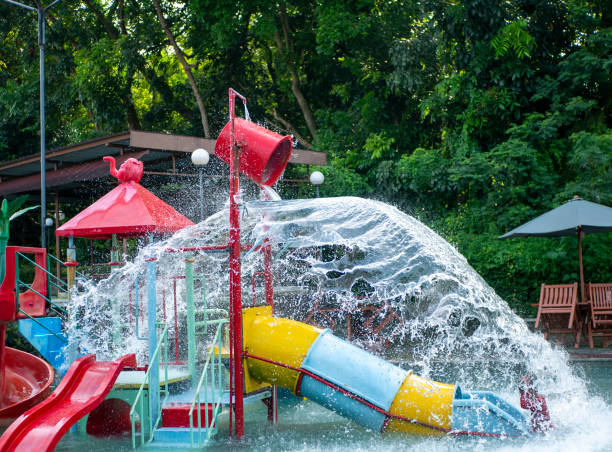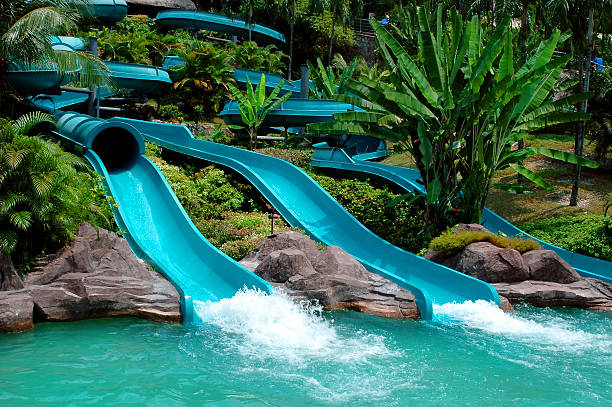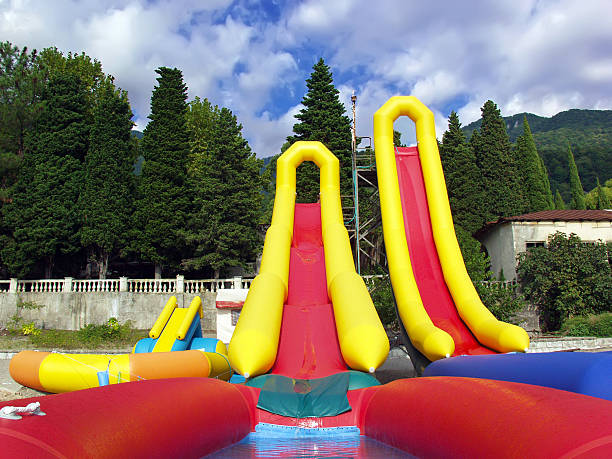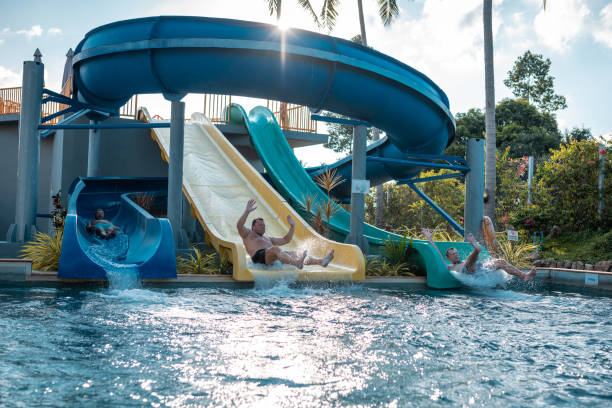Water parks are a favorite destination for families, friends, and thrill-seekers alike. These recreational havens offer a mix of fun, adventure, and relaxation with their exciting rides, refreshing pools, and attractions for all ages. Water parks come in various sizes and themes, but their core purpose remains the same: to provide a cool escape during warm months and a memorable exp
In this comprehensive guide, we will explore everything you need to know about water parks, including their history, popular attractions, safety tips, and the many benefits they offer. By the end, you’ll have a deeper appreciation for these aquatic playgrounds and be ready to dive into your next water park adventure.




1. The History of Water Parks
Water parks, as we know them today, are relatively modern inventions. However, the concept of combining water with recreation goes back centuries. Ancient civilizations, including the Greeks and Romans, built elaborate public baths and pools where people would gather to swim and socialize. In the 20th century, the idea of water-themed amusement parks began to take shape.
- First Modern Water Parks: The first water park in the United States, Wet ‘n Wild, opened in Orlando, Florida, in 1977. Created by George Millay, it set the standard for modern water parks with its wave pools, water slides, and lazy rivers. The success of Wet ‘n Wild sparked the development of similar parks across the country.
- Global Expansion: Today, water parks can be found worldwide, from small community pools with water features to massive resorts with multiple themed areas. Water parks have also evolved to include indoor facilities, making them year-round attractions in colder climates.
2. Popular Water Park Attractions
One of the reasons water parks are so beloved is the variety of attractions they offer. From high-speed water slides to relaxing wave pools, there’s something for everyone, regardless of age or adventure level. Here are some of the most popular water park attractions:
a. Water Slides
Water slides are the centerpiece of most water parks. They come in many forms, from towering slides with steep drops to enclosed tube slides that twist and turn. These rides provide an adrenaline rush, making them popular among thrill-seekers.
- Body Slides: These slides are designed for riders to slide down without a raft or tube. Body slides range from gentle slopes to extreme vertical drops, like the famous “Summit Plummet” at Disney’s Blizzard Beach, which boasts a near-vertical freefall.
- Tube Slides: Riders sit in an inflatable tube as they travel down winding slides, often through enclosed tunnels or open-air sections. These slides can be enjoyed solo or in tandem with others, making them a fun option for families and friends.
- Racing Slides: Perfect for competitive groups, racing slides allow multiple riders to slide down parallel lanes at the same time, competing to see who reaches the bottom first.
b. Lazy Rivers
For those looking to relax, lazy rivers are a staple attraction at water parks. These slow-moving, circular rivers allow guests to float on inner tubes as they drift along a winding path. Lazy rivers provide a peaceful escape from the more intense rides and give visitors a chance to unwind while staying cool.
c. Wave Pools
Wave pools simulate the experience of being in the ocean, creating artificial waves that range from gentle ripples to large swells. Guests can swim or float as the waves roll in, providing both a relaxing and thrilling experience, depending on the intensity of the waves.
d. Splash Pads and Kiddie Areas
Water parks are designed to accommodate guests of all ages, including young children. Splash pads and kiddie areas feature shallow pools, water sprayers, fountains, and mini slides. These areas are perfect for toddlers and younger kids who want to enjoy the water in a safe, low-risk environment.
e. Water Coasters
Water coasters are a unique blend of traditional roller coasters and water slides. These rides use powerful jets of water to propel rafts or riders up and down hills, around sharp turns, and through various twists and drops. They are one of the most exciting innovations in water park design.
f. Wave Riders and Surf Simulators
Some water parks offer surf simulators, where guests can try their hand at riding artificial waves on boogie boards or surfboards. These attractions provide a fun challenge and the thrill of surfing without needing to visit the ocean.
3. Safety Tips for Water Parks
While water parks are all about fun, safety is a top priority. Here are some essential safety tips to keep in mind when visiting a water park:
a. Follow the Rules
Each ride and attraction at a water park has specific safety rules posted. These rules are there to keep everyone safe, so it’s important to follow them. This includes height and weight restrictions, as well as instructions on how to properly sit or position yourself on rides.
b. Stay Hydrated
With all the water around, it’s easy to forget that spending time in the sun can lead to dehydration. Make sure to drink plenty of water throughout the day, especially if you’re spending a lot of time in the sun or on active rides.
c. Apply Sunscreen Regularly
Sunburn can happen quickly, especially when you’re in and out of the water. Apply sunscreen with a high SPF before you enter the park and reapply it throughout the day, especially after swimming or using water slides.
d. Supervise Young Children
Water parks are designed for family fun, but young children should always be supervised, especially in pools or on water rides. Many water parks offer life jackets for children, so take advantage of this safety measure if needed.
e. Know Your Limits
While it’s tempting to try every ride, it’s important to know your physical limits. Water slides and other attractions can be physically demanding, and it’s okay to take breaks and rest in between rides.
4. Health and Wellness Benefits of Water Parks
Beyond the obvious fun and excitement, water parks offer several health and wellness benefits:
a. Physical Exercise
Water parks provide a great opportunity for physical activity. Whether you’re climbing stairs to the top of a slide, swimming in a wave pool, or navigating a lazy river, you’re engaging in cardiovascular exercise. These activities help improve stamina, burn calories, and strengthen muscles without feeling like a traditional workout.
b. Stress Relief
Water has long been known for its calming effects. The gentle movement of water in lazy rivers or wave pools can help reduce stress and promote relaxation. Additionally, the joy and laughter that come from riding water slides or playing in splash zones can elevate mood and reduce anxiety.
c. Family Bonding
Water parks provide a unique environment for families to bond. Whether it’s waiting in line for a ride, floating together on a lazy river, or watching children play in a kiddie area, water parks offer plenty of opportunities for shared experiences and family connection.
5. Top Water Parks Around the World
While water parks can be found worldwide, some stand out for their size, design, and attractions. Here are a few of the top water parks worth visiting:
a. Blizzard Beach (Orlando, Florida)
Part of the Walt Disney World Resort, Blizzard Beach is one of the most famous water parks in the world. With a unique winter-ski-resort theme, this park features a wide range of water slides, including the towering Summit Plummet, one of the tallest and fastest freefall slides in the world.
b. Siam Park (Tenerife, Spain)
Siam Park is often ranked as the best water park in the world. Located on the Canary Island of Tenerife, this Thai-themed park offers impressive rides, including the Tower of Power, a near-vertical slide that sends riders through a shark tank.
c. Aquatica (Orlando, Florida)
Aquatica, owned by SeaWorld, is known for its combination of thrilling rides and marine life exhibits. The park features rides like Dolphin Plunge, where riders slide through clear tubes that pass through a lagoon filled with dolphins.
d. Yas Waterworld (Abu Dhabi, UAE)
Yas Waterworld is one of the largest water parks in the Middle East, featuring over 40 rides and attractions. Highlights include Dawwama, the world’s largest tornado water coaster, and the Bandit Bomber, a water roller coaster that offers interactive water effects.
6. Sustainability in Water Parks
With water being a primary resource, many modern water parks are taking steps to operate more sustainably. This includes using recycled water, minimizing energy consumption, and employing eco-friendly materials.
- Water Conservation: Some parks have implemented water recycling systems that capture, filter, and reuse water for rides and attractions. This helps reduce the overall water consumption while maintaining a fun experience for guests.
- Solar Energy: Many parks have adopted renewable energy sources, such as solar panels, to power their attractions, reducing their carbon footprint.
Conclusion
Water parks are more than just a place to cool off on a hot day—they are destinations for adventure, relaxation, and creating lasting memories with family and friends. Whether you’re a thrill-seeker looking for the fastest slide or a parent looking for a safe space for your children to play, water parks offer something for everyone. With safety in mind and the growing focus on sustainability, these parks will continue to be popular and exciting destinations for years to come.







